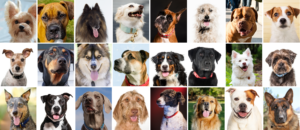National Canine Research Council Summary and Analysis:
This is an inter-rater reliability study, the primary goal of which was to determine the level of agreement between shelter workers in the US and the UK regarding dogs they labeled “pit bulls.” There was no attempt to establish validity (e.g., by comparison with DNA results).
Participants were 470 shelter and adoption agency staff and volunteers (416 from the US, 54 from the UK) who, as in Olson 2015, indicated that their role involved assigning breed to dogs based on visual identification. Participants completed a breed identification survey online in which they viewed photos of 20 dogs of unknown origin and wrote in what breed they would assign to each dog, whether they consider the dog to be a “pit bull,” and what would be done with each dog at the shelter for which they worked. Participants were also given a list of 10 breed names that the authors considered to be “bull breeds” or “Mastiff breed names” and were asked to indicate whether they considered the breed as an alternative name for a “pit bull” or “pit bull-type” dog.
The majority (>50%) of US and UK participants agreed on primary breed for only 10 of the 20 dogs. A majority of US participants identified 7 of the 20 dogs as “pit bulls” but for UK respondents only 1 of the 20 was thought to be a “pit bull.” US participants were significantly more likely to classify six of the ten breeds the authors considered to be “bull breeds” or “Mastiff breeds” (American bulldog, American Staffordshire terrier, English bull terrier, miniature bull terrier, Presa Canario, and Staffordshire bull terrier) as “pit bulls” than were their UK counterparts. There was not strong agreement between or within the shelter workers in two countries in terms of breed identification.
Since Hoffman, Harrison, Wolff, and Westgarth note that there are many conflicting definitions of which breeds can be considered a “pit bull,” it is puzzling that they seem to accept the idea that a “bull breed” group exists when there is no agreed upon classification for any of the terms / groupings—not in science, the law, kennel clubs, or animal shelters. They also refer to “pit bull terriers” as though this is a recognized breed or group (American Pit Bull Terrier is a breed recognized by some kennel clubs, but that breed name is not used in text, and it is not clear that this is what the authors are referring to as they seem to use it interchangeably with “pit bull”).
Ultimately, this study showed that there are discrepancies regarding which breeds different people consider to be “pit bulls.” The importance of this cannot be overstated considering that the labels can have life and death consequences. The authors suggest that how a particular locale defines “pit bull” will influence how dogs are identified by shelter and/or rescue workers, which may in turn affect their probability of being made available for adoption. The difference in opinion between participants is indicative of the lack of inter-observer reliability of visual breed identification. Furthermore, because these participants regularly perform this task as part of their job, the findings cast doubt on the validity of visual breed identification as a general practice for canine professionals.
Though this study focused on visual breed identification of dogs labeled “pit bulls,” the data are in line with other reports that demonstrate widespread inconsistency and unreliability of visual breed identification. Since dogs labeled “pit bulls” are often the target of Breed-Specific Legislation, the specificity of the data should not be discounted. In conjunction with the related reports by Voith, et al. (2009; 2013), the evidence is damning and highly supports Simpson, et al.’s (2012) plea for a change in protocol.
Additional references:
Page last updated July 15, 2019





